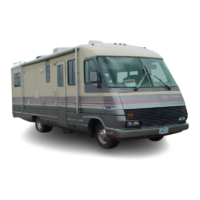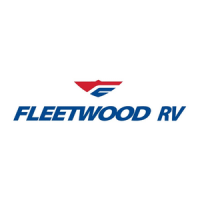DRIVE
BELTS
Proper care
and
maintenance
of
drive
belts
is an
important
part
of
good
engine
maintenance.
Proper
belt
tension
and
the
condition
of
the
pulley
grooves
are
of
primary
concern.
Since
belts
and
pulleys
wear
with
use,
look
at
all
frictional
surface areas
for
signs
of
wear. Normal wear
can
be recognized as even wear,
both
on
the
belt
and
the
grooves
of
the
pulley. Even
with
normal wear, belts
will
eventually
show
evidence
of
cracking.
Replace
belts
before
or as soon
as
cracking
becomes
evident.
Unusual
signs
of
wear
indicate
some
corrective
ac-
tion
is necessary. .
When
checking,
remember
failed
or
partially
failed
belts
may
have
been
damaged
by
a bad pulley, a
misaligned
drive
or
by
some
faulty
mechanical
component.
Always
check
the
condition
of
pulleys before replac-
ing
belts.
Inspect
the
pulleys
for
chips, cracks,
bent
sidewalls,
rust,
corrosion,
etc. Replace
any
defective
pulleys.
EXTERIOR
Some
exterior
parts
of
your
motor
home
are
made
of
fiberglass.
The
finish
on these
parts
is durable,
but
not
indestructible.
Any
material
and
finish
will
deteriorate
in
time. Exposure
to
sunlight,
moisture
and
airborne
pollutants
can
chemically
alter
the
composi-
tion
of
the
base
and
finish
materials
and
cause
dull-
ing
and
fading
of
the
finish. Generally,
changes
in
the
",
finish
due
to
weathering
are
cosmetic
-
they
are on
'.i
'the
surface
of
the
part
and
do
not
affect
its
strength.
Weatheri,ng
can
take
several
forms:
•
Chalking
-
The
surface
finish
has broken
down
into
a
fine
powder.
It
usually
will
wash
off.
• Fading - The
color
of
the
finish has changed. This
can
be
caused
by
chemicals
spilled on
the
sur-
face,
staining
it,
or
by
changes
in
the
pigments
used
in
the
finish.
•
Yellowing
'-
Usually
caused
by
chemical
changes
in
the
material
and
pigments.
The
best
insurance
against
these
effects
is
routine
maintenance.
If
the
finish
is
not
washed
thoroughly
and
waxed,
the
surface
can deteriorate
very
rapidly.
The
following
maintenance
guidelines can
help
you
reduce
these
weathering
effects:
1.
Wash
the
exterior
of
the
motor
home
monthly,
at
least. Wash
with
a mild soap. Avoid
strong
alkaline
cleaners
and
abrasives.
2.
Wax
the
exterior
at least once a year -
twice,
if
possible
-
with
a
wax
formulated
for
fiberglass.
When
waxing,
always
read and
follow
the
instruc-
tions
and
pr~cautions
on
the
container.
Some
cleaners
and
waxes
are
recommended
for
use
on
only
certain
types
of
surfaces. Sometimes one part
may
weather
more
rapidly
than
others.
In
cases
where
this
has
happened, a
light
rubbing
com-
43
pound
may
be required.
Always
follow
rubbing
compound
with
a
high-quality
wax.
Stains
Staining can
generally
be
caused
by
two
types
of
substances
-
water
soluble
and
non-water
soluble.
Water soluble stains can usually be
washed
away
with
water
and
mild
detergents
or
a
fine
cleanser.
If
you
use
a cleanser
powder,
first
mix
it
with
water
form-
ing a
runny
paste.
Start
with
a
small
spot,
and
use
light,
circular
rubbing
motions.
Fallaw
the
washing
with
wax.
Non-water
soluble
stains
are
usually
oil-based.
Removal
of
this
type
of
stain
may
require
the
use
of
highly
flammable
or
poisonous
solvents.
Refer thiS
type
of
service
to
your
dealer
or
an
authorized
Fleet-
wood
Service Center. Wash
the
exterior
of
the
motor
home
as
you
would
your
car
or
truck.
Never
use
strong
solvents
or
harsh
abrasives
to
clean
the
ex-
terior
metal
or
fiberglass
surfaces.
A
good
quality
automotive
wax-polish
will
help
maintain
the
finish.
Windows,
Doors,
Vents &
Locks
Keep moving parts
of
windows
and latches adjusted
and maintained. Lubricate
the
windows
with
a
light
oil
or
powdered
graphite
at
least
once
a year.
Check
and
tighten
the
screws
holding
the
windows
in
place
periodically.
Check
the
weather
sealant.
See
SEALANT
RENEWAL.
Clean
screens
by
gently
wip-
ing
with
a
damp
cloth
or
soft
flat
brush.
Inspect
the
sealants
around
doors
and
windows
every three
months.
See
SEALANT
RENEWAL.
Lubricate
locksets, latches and hinges in
entry
doors
and
.exterior
storage
compartments
at
least
annually
with
powdered graphite.
If
the
motor
home
is
Idcated
at
a beach or is
exposed
to
salt
air,
more
frequent
lubrication
may
be required. Record
the
identification
number
of
the
keys in
the
records
space
provided
in
this
manual.
This'
information
will
help
you
get
duplicate
keys in
the
event
of
loss.
Sealant
Renewal
The
adhesives
and
sealants
used
in
the
construc-
tion
of
your
motor
home
were
developed
to
remain
waterproof
under
sustained
effects
of
weather
and
vibration. However, even
the
finest
materials
will
even-
tually
dry
out
and lose
their
effectiveness
under
con-
stant
heat
of
the
sun and
attack
by
other
elements.
This
section
outlines
the
procedures
that
you
must
follow
to
maintain
the
weatherproof
integrity
of
your
motor
home. Leak damage caused by
neglect
to
follow
these procedures
may
affect
your
warranty
coverage.
Your
dealer can
perform
the
resealing
inspection
and work
for
you. He has
current
information
on
sealants used in
your
motor
home, and
can
recom-
mend
the
appropriate
sealants
for
you
if
you
prefer
to
do this
work
yourself.
Always
use the
recommend-
ed sealants.

